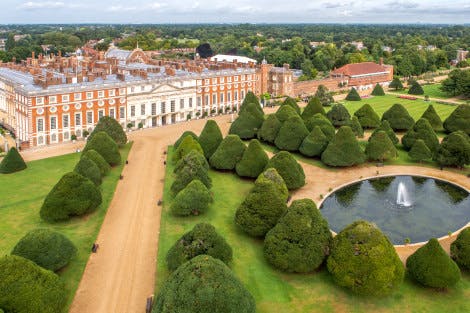This little watercolour, painted by an unknown artist in the 1850s, is a revealing glimpse of what it was like to visit Hampton Court Palace in the 19th century.
Back then, the state apartments were overwhelmingly presented to the visiting public as an art gallery, richly dressed with the artistic treasures of the Royal Collection. The official guidebooks contained brief histories of the palace, followed by an exhaustive list of 1,000 paintings (the most important were asterisked for weary eyes).

Image: ‘The Long Gallery’ (now known as ‘The Queen’s Gallery) at Hampton Court Palace, c1853-62, by an unknown artist. © Historic Royal Palaces
There were over a hundred, here, in the Queen’s Gallery: among them Rubens’ Diana and her Nymphs and artworks by Durer, Tintoretto, Rembrandt and Mytens.
The Hampton Court picture galleries were one of the first, and most prominent, public art museums in the country. Yet, soon after they had opened, more modern galleries rivalled and eclipsed Hampton Court.
The new National Gallery in Trafalgar Square and the South Kensington Museum (which later became the Victoria & Albert Museum) had better lighting, a more systematic arrangement of pictures and, to put it simply, less clutter.
Over the last three months, I have been researching these picture hangs, transcribing unpublished inventories of the collections, identifying what went where, and how the hang developed from 1838, when the palace opened to the general public for the first time, until the 1880s.
What has emerged is a curious collection of important artworks, unfashionable paintings not wanted at Buckingham Palace or Windsor Castle, and unknown portraits from the distant royal past. In order to squeeze as much in as possible, devotional religious artwork hung alongside bawdy Dutch scenes of everyday life, while unknown Venetian gentlemen (there were quite a few of these listed in the 19th century handlists!) conversed with forgotten ladies of the British court.
Resolute attempts to improve the conditions and displays at the palace could not do anything about the fact that the state apartments had not, for the most part, been designed for the display of paintings.
Ultimately – but this wasn’t until the 20th century – the picture galleries were replaced by a more historic picture hang, with paintings displayed as part of a furnished interior, which today tells the story of the people who lived at Hampton Court, rather than the story of art.
And yet... art at Hampton Court remains a compelling narrative. The palace still houses some of the greatest treasures of the Royal Collection, from Mantegna’s masterpiece, The Triumphs of Caesar to paintings by Holbein, Van Dyck and Rubens.
Some of the most important are still displayed, as works of art, in the Cumberland Art Gallery at the palace. If you visit in the next few months, you will also see this little watercolour of the Queen’s Gallery, and perhaps feel part of the long tradition of visiting paintings at the palace.
Brett Dolman
Collections Curator
More from our blog

The Wedding of Captain Scott and Kathleen Bruce at Hampton Court Palace
04 January 2024
Assistant Curator Minette Butler explores how Captain Scott's wedding to his beloved wife Kathleen Bruce at Hampton Court Palace intertwines with the aftermath of his ill-fated expedition to reach the South Pole.

Sir Christopher Wren's Hampton Court Palace
08 March 2023
Head of Historic Buildings Daniel Jackson looks at one of Sir Christopher Wren's most famous and problematic projects: the remodelling of Hampton Court Palace.

A Queer Walk through Hampton Court Palace
11 February 2021
When you next visit Hampton Court, bring a queer eye to the palace. Shift your perception. Actively look around you. I promise there is a rich history to find.
